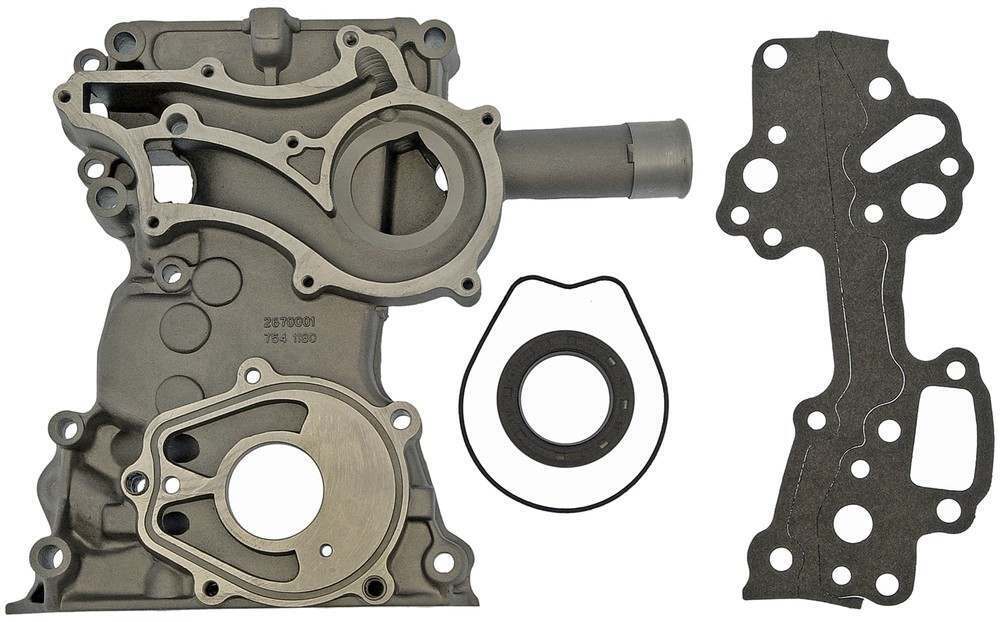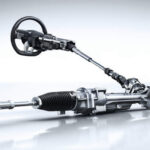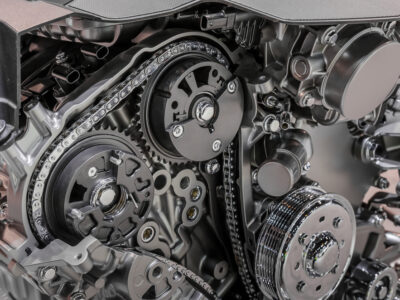
Replacing the Timing Cover Seal on a Fiat 500 TwinAir Engine

The Fiat 500 TwinAir engine is a marvel of modern engineering, offering impressive fuel efficiency and performance. However, like any mechanical component, it requires regular maintenance to ensure optimal operation. One crucial aspect is the timing cover seal, which can deteriorate over time, leading to oil leaks and potential engine damage. Replacing this seal is a relatively straightforward process, but it demands attention to detail and a clear understanding of the engine's mechanics. In this article, we'll guide you through the steps involved in replacing the timing cover seal on a Fiat 500 TwinAir engine.
- Replacing the Timing Cover Seal: A Step-by-Step Guide for Fiat 500 TwinAir Engine
- What problems does the 0.9 TwinAir cause in a Fiat 500?
- Is a timing cover gasket leak serious?
- What happens if a timing belt breaks on a Fiat 500?
- Does the Fiat 500 Twin Air have a timing belt or chain?
- Frequently Asked Questions
- What is the purpose of the timing cover seal on a Fiat 500 TwinAir engine?
- What are the signs that the timing cover seal needs to be replaced?
- Can I replace the timing cover seal on my Fiat 500 TwinAir engine myself?
- How long does it take to replace the timing cover seal on a Fiat 500 TwinAir engine?
Replacing the Timing Cover Seal: A Step-by-Step Guide for Fiat 500 TwinAir Engine
Replacing the timing cover seal on a Fiat 500 TwinAir engine is a task that requires precision and attention to detail. The timing cover seal plays a crucial role in maintaining the integrity of the engine's timing system, preventing oil leaks, and ensuring that the engine operates smoothly. The TwinAir engine, known for its efficiency and performance, demands regular maintenance to uphold its standards. Replacing the timing cover seal is part of this maintenance routine, aimed at preventing potential issues that could lead to more significant problems if neglected.
Preparation and Tools Needed
Before starting the replacement process, it's essential to gather all the necessary tools and materials. This includes a new timing cover seal compatible with the Fiat 500 TwinAir engine, a socket set, and other basic mechanic's tools. Having the correct tools on hand simplifies the process and reduces the risk of damaging other engine components. Ensure that the workspace is clean and well-lit to facilitate the procedure.
Removing the Timing Cover
To access the timing cover seal, the timing cover must be removed. This involves disconnecting the battery to prevent any accidental engine starts, followed by the removal of the serpentine belt and other components that obstruct access to the timing cover. The timing cover is then taken off by removing the bolts that hold it in place. Care must be taken to avoid damaging the cover or the surrounding engine components.
Installing the New Seal
With the timing cover removed, the old seal can be taken out and replaced with the new one. It's crucial to inspect the sealing surface for any signs of wear or damage and to ensure that the new seal is properly seated. The timing cover is then reinstalled, and all bolts are tightened to the specified torque to prevent leaks. Reconnecting the battery and other components completes the replacement process.
| Tool/Part | Description | Importance |
|---|---|---|
| New Timing Cover Seal | Compatible with Fiat 500 TwinAir engine | Essential for preventing oil leaks |
| Socket Set | For removing bolts and other fasteners | Necessary for accessing the timing cover |
| Mechanic's Tools | Basic tools for handling engine components | Required for a smooth replacement process |
What problems does the 0.9 TwinAir cause in a Fiat 500?

The 0.9 TwinAir engine in a Fiat 500 is known to cause several problems. One of the main issues is related to its reliability and durability. Some owners have reported experiencing engine problems, such as rough idling, stalling, and decreased performance.
Common Issues with the 0.9 TwinAir Engine
The 0.9 TwinAir engine is prone to certain issues that can affect its overall performance and reliability. Some of the common problems include issues with the timing chain, oil leaks, and faulty sensors. These problems can be caused by a variety of factors, including poor maintenance, driving conditions, and manufacturing defects.
- Timing chain issues can cause the engine to jump timing, leading to costly repairs.
- Oil leaks can cause damage to other engine components and lead to decreased performance.
- Faulty sensors can cause the engine to run rough or stall, leading to decreased reliability.
Performance Issues with the 0.9 TwinAir Engine
The 0.9 TwinAir engine is known to have some performance issues, particularly in certain driving conditions. Some owners have reported experiencing decreased power and torque, especially when driving uphill or carrying heavy loads. This can be caused by a variety of factors, including issues with the engine's turbocharger, fuel system, or ignition system.
You may be interested in reading Fixing a Vibrating Clutch Pedal in Diesel Fiat 500 Models
Fixing a Vibrating Clutch Pedal in Diesel Fiat 500 Models- Turbocharger issues can cause a decrease in power and torque.
- Fuel system problems can cause the engine to run lean or rich, leading to decreased performance.
- Ignition system issues can cause the engine to misfire, leading to decreased power and efficiency.
Maintenance and Repair Costs for the 0.9 TwinAir Engine
The 0.9 TwinAir engine requires regular maintenance to ensure its reliability and performance. Some owners have reported experiencing high maintenance and repair costs, particularly if they neglect to follow the recommended maintenance schedule. This can be caused by a variety of factors, including the cost of replacement parts, labor costs, and the complexity of repairs.
- Regular oil changes and filter replacements can help to prevent costly repairs.
- Replacing the timing chain and other wear parts can be expensive.
- Labor costs can be high, particularly if the repair requires specialized tools or expertise.
Is a timing cover gasket leak serious?
A timing cover gasket leak can be a significant issue for an engine, potentially leading to various problems if not addressed promptly. The timing cover gasket plays a crucial role in sealing the timing cover to the engine block, preventing oil leaks from the timing cover area. When this gasket fails or deteriorates, it can allow engine oil to escape, leading to decreased oil levels, increased risk of oil dripping onto other components, and potentially causing damage to other parts of the engine or the vehicle's undercarriage.
Potential Consequences of Ignoring the Leak
Ignoring a timing cover gasket leak can have several negative consequences on the overall health and performance of the engine. For instance, continued oil leakage can lead to a reduction in engine oil levels, which is critical for lubricating moving parts within the engine. Lower oil levels can result in increased wear on engine components, potentially leading to premature wear or even engine failure if not properly maintained.
- Engine components may suffer from increased wear due to inadequate lubrication.
- The risk of engine overheating increases as oil plays a role in cooling certain engine parts.
- Oil leaks can also lead to the accumulation of dirt and debris on the engine and surrounding components.
Signs and Symptoms of a Timing Cover Gasket Leak
Identifying a timing cover gasket leak early on is crucial for preventing more severe damage. Common signs include visible oil leaks from the timing cover area, low oil levels, and potentially, the illumination of the oil pressure warning light on the dashboard. Upon noticing any of these symptoms, it's essential to inspect the timing cover gasket and surrounding areas for signs of leakage or damage.
- Visible oil droplets or stains under the vehicle or on the engine.
- A decrease in engine oil level between oil changes.
- The presence of oil on the timing cover or surrounding engine components.
Repairing a Timing Cover Gasket Leak
Repairing a timing cover gasket leak involves replacing the damaged gasket with a new one. This process can vary in complexity depending on the engine design and the location of the timing cover. Generally, it requires draining the engine oil, removing the timing cover, and then replacing the gasket before reassembling everything. It's also a good opportunity to inspect other related components for any signs of wear or damage.
- Drain the engine oil to prevent spills during the repair.
- Remove any components necessary to access the timing cover, such as serpentine belts or other accessories.
- Inspect the timing cover and engine block mating surfaces for any signs of damage or excessive wear.
What happens if a timing belt breaks on a Fiat 500?

If a timing belt breaks on a Fiat 500, it can cause significant damage to the engine. The timing belt plays a crucial role in synchronizing the rotation of the crankshaft and camshaft, ensuring that the engine's valves and pistons operate in harmony. When the timing belt breaks, this synchronization is lost, and the engine can suffer severe damage.
Engine Damage
A broken timing belt can cause the engine's valves and pistons to collide, resulting in costly repairs. The extent of the damage depends on various factors, including the engine type and the circumstances surrounding the belt failure.
Some possible consequences of engine damage due to a broken timing belt include:
 Fixing a Vibrating Clutch Pedal in Diesel Fiat 500 Models
Fixing a Vibrating Clutch Pedal in Diesel Fiat 500 Models Replacing Worn Suspension Components on a Fiat 500
Replacing Worn Suspension Components on a Fiat 500- Bent valves that require replacement
- Damage to the piston heads or cylinder walls
- Potential need for a new engine or major engine overhaul
Warning Signs
In some cases, a timing belt may exhibit warning signs before breaking. Being aware of these signs can help prevent a catastrophic failure.
Some common warning signs that a timing belt may be about to fail include:
- Cracking or wear on the belt's surface
- Unusual noises coming from the timing belt area
- Engine misfires or rough idling
Preventive Measures
To avoid the costly consequences of a broken timing belt, it's essential to take preventive measures. Regular maintenance can help identify potential issues before they become major problems.
Some recommended preventive measures include:
- Regularly inspecting the timing belt for signs of wear
- Replacing the timing belt at the recommended interval
- Monitoring the engine for any unusual signs or symptoms
Does the Fiat 500 Twin Air have a timing belt or chain?

The Fiat 500 Twin Air engine uses a timing chain rather than a timing belt. This is a significant design choice because it impacts the maintenance and reliability of the engine.
Timing Chain vs. Timing Belt
The decision to use a timing chain instead of a timing belt in the Fiat 500 Twin Air engine is noteworthy. A timing chain is generally considered to be more durable and longer-lasting than a timing belt, as it is designed to last the lifetime of the engine. Here are some key differences between the two:
- A timing chain is typically more durable and requires less maintenance than a timing belt.
- Timing chains are usually designed to last the lifetime of the engine, whereas timing belts have a specific replacement interval.
- The use of a timing chain can reduce the risk of engine damage in the event of a timing component failure.
Maintenance Requirements for the Timing Chain
Although the timing chain is designed to be more durable and long-lasting, it is still important to follow the recommended maintenance schedule for the Fiat 500 Twin Air engine. Regular maintenance can help to ensure the longevity and reliability of the timing chain. Here are some key maintenance tasks to consider:
- Regular oil changes are essential to keep the timing chain well-lubricated and running smoothly.
- Inspection of the timing chain and its components at regular intervals can help to identify any potential issues before they become major problems.
- Any unusual noises or symptoms related to the timing chain should be investigated promptly by a qualified mechanic.
Implications for Engine Reliability
The use of a timing chain in the Fiat 500 Twin Air engine has implications for engine reliability. A well-maintained timing chain can contribute to the overall reliability of the engine. Here are some factors to consider:
- A timing chain that is properly maintained can help to prevent engine damage and reduce the risk of costly repairs.
- The durability of the timing chain can help to minimize the risk of engine failure due to timing component failure.
- Regular maintenance and inspections can help to identify any potential issues with the timing chain before they become major problems.
Frequently Asked Questions
What is the purpose of the timing cover seal on a Fiat 500 TwinAir engine?
The timing cover seal is a critical component that prevents oil leaks from the timing cover area. It ensures the engine remains lubricated and runs smoothly. A faulty seal can cause oil to escape, potentially leading to engine damage and decreased performance. Replacing the seal is essential to maintain the engine's integrity and prevent costly repairs.
What are the signs that the timing cover seal needs to be replaced?
Signs that the timing cover seal needs replacement include oil leaks around the timing cover area, decreased engine performance, and potentially, the illumination of the oil pressure warning light on the dashboard. Visible oil drips or stains under the car or on the engine itself are also indicators. If you notice any of these symptoms, inspect the seal and consider replacing it to avoid further engine damage.
You may be interested in reading Fixing a Vibrating Clutch Pedal in Diesel Fiat 500 Models
Fixing a Vibrating Clutch Pedal in Diesel Fiat 500 Models Replacing Worn Suspension Components on a Fiat 500
Replacing Worn Suspension Components on a Fiat 500 How to Replace a Faulty Power Steering Motor in a Fiat 500
How to Replace a Faulty Power Steering Motor in a Fiat 500Can I replace the timing cover seal on my Fiat 500 TwinAir engine myself?
Replacing the timing cover seal on a Fiat 500 TwinAir engine is a task that can be undertaken by a skilled DIY mechanic. It requires specific tools and a good understanding of engine mechanics. The process involves removing the timing cover, inspecting and cleaning the area, and installing a new seal. However, if you're not confident in your abilities, it's recommended to consult a professional mechanic to ensure the job is done correctly.
How long does it take to replace the timing cover seal on a Fiat 500 TwinAir engine?
The time it takes to replace the timing cover seal can vary depending on your level of experience and the tools available. Generally, it can take several hours to complete, as it involves removing the timing cover and other components to access the seal. Ensure you allocate sufficient time and have a clear workspace to complete the task efficiently and effectively.

If you want to know other articles similar to Replacing the Timing Cover Seal on a Fiat 500 TwinAir Engine you can visit the category Maintenance.
Deja una respuesta






More content of your interest